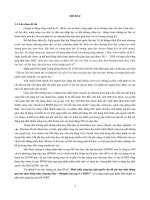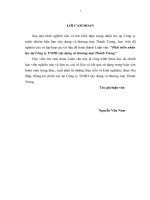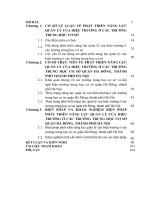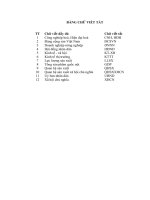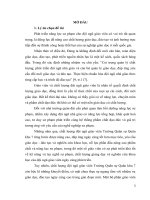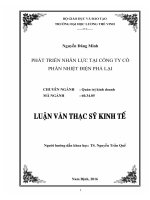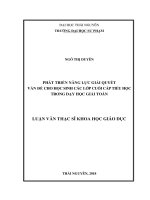luận văn thạc sĩ phát triển động lực đọc của học sinh trung học phổ thông qua việc đọc thêm trường hợp của học sinh lớp 12 tại một trường trung học phổ thông ở tỉnh hà nam
Bạn đang xem bản rút gọn của tài liệu. Xem và tải ngay bản đầy đủ của tài liệu tại đây (328.65 KB, 87 trang )
VIETNAM NATIONAL UNIVERSITY, HA NOI UNIVERSITY OF
LANGUAGES AND INTERNATIONAL STUDIES FACULTY OF
POST - GRADUATE STUDIES
VŨ DIỆU HUYỀN
DEVELOPING HIGH SCHOOL STUDENTS’ READING
MOTIVATION THROUGH EXTENSIVE READING:
THE CASE OF 12
TH
GRADERS AT A HIGH SCHOOL
IN HA NAM PROVINCE
(Phát triển động lực đọc của học sinh trung học phổ thông qua việc
đọc thêm: Trường hợp của học sinh lớp 12 tại một trường trung học
phổ thông ở tỉnh Hà Nam)
M.A MINOR THESIS
FIELD: ENGLISH TEACHING METHODOLOGY
CODE: 8140231.01
HANOI, 2019
VIETNAM NATIONAL UNIVERSITY, HA NOI UNIVERSITY OF
LANGUAGES AND INTERNATIONAL STUDIES FACULTY OF
POST - GRADUATE STUDIES
VŨ DIỆU HUYỀN
DEVELOPING HIGH SCHOOL STUDENTS’ READING
MOTIVATION THROUGH EXTENSIVE READING:
THE CASE OF 12
TH
GRADERS AT A HIGH SCHOOL
IN HA NAM PROVINCE
(Phát triển động lực đọc của học sinh trung học phổ thông qua việc đọc
thêm: Trường hợp của học sinh lớp 12 tại một trường trung học phổ
thông ở tỉnh Hà Nam)
M.A MINOR THESIS
FIELD: ENGLISH TEACHING METHODOLOGY
CODE: 8140231.01
Supervisor: Assoc. Prof.Dr. Lê Văn Canh
HANOI, 2019
DECLARATION
I hereby certify that this minor thesis entitled “Developing high school
th
students’ reading motivation through extensive reading: The case of 12 graders at
a high school in Ha Nam Province” is entirely the study of my own work, which
has not been submitted before any degree or examination in any other university,
and that all the sources I have used or quoted have been indicated and
acknowledged by means of complete references.
Hanoi, November 2019
Signature
Vu Dieu Huyen
i
ACKNOWLEDGEMENTS
I would like to express my gratitude to people who gave me the possibility to
complete this master‟s project.
First of all, I would like to express my deepest gratitude and love to my
thesis supervisor, Assoc. Prof. Dr. Le Van Canh, who has been generous with his
feedback, time and patience. It is his invaluable and insightful comments, guidance,
and encouragement that helps me fulfill my minor thesis.
My sincere gratitude is also extended to all lecturers and staff of Postgraduate
Studies for their useful lectures, materials, guidance and enthusiasm during my course.
I would like to gratefully acknowledge the support from my colleagues and
students, especially students of classes 12A1 and 12A4, who have inspired and
guided me in the accomplishment of the study.
Last but not least, I would like to thank my beloved family for their
understanding, support and encouragement. Without them, I would not have been
able to finish this thesis.
ii
ABSTRACT
Extensive reading is believed to be one of the effective tools to develop
students‟ good reading habit and reading motivation. However, little has been done
to measure the effects of extensive reading on leaners‟ reading motivation. Thus,
the present study was conducted under the action research to investigate the effect
of extensive reading on learners‟ motivation for reading. The participants were 86
students from classes 12A1 and 12A4 of a high school in Ha Nam Province through
an 8-week trial period. In order to collect data for the research, a pre-intervention
questionnaire, and post questionnaire were employed. After a preliminary
investigation via pre-intervention questionnaire, an extensive reading program was
designed and then implemented during 8 first weeks of the first semester of the
school year 2019-2020. The result from post questionnaire showed that there has
been great improvement in the students‟ reading motivation. Besides, students also
expressed positive attitudes towards this program and their intention to continue this
program afterwards.
iii
TABLE OF CONTENTS
DECLARATION...................................................................................................... i
ACKNOWLEDGEMENTS.................................................................................... ii
ABSTRACT............................................................................................................ iii
LIST OF ABBREVIATION.................................................................................. vii
LIST OF TABLES................................................................................................ viii
CHAPTER 1: INTRODUCTION.......................................................................... 1
1. Rationale of the study............................................................................................ 1
2. Aims of the study................................................................................................... 2
3. Research questions................................................................................................ 2
4. Scope of the study................................................................................................. 2
5. Significance of the study....................................................................................... 2
6. Method of the study............................................................................................... 3
7. Organization of the thesis...................................................................................... 3
CHAPTER 2: LITERATURE REVIEW............................................................... 4
2.1. Reading.............................................................................................................. 4
2.1.1. Definition of reading....................................................................................... 4
2.1.2. Roles of reading in second language teaching................................................. 5
2.1.3. Intensive reading vs. extensive reading........................................................... 6
2.2. Extensive reading.............................................................................................. 8
2.2.1. Definition of extensive reading....................................................................... 8
2.2.2. Characteristics and principles of extensive reading......................................... 9
2.2.3. Constraints on developing an extensive reading program for students..........11
2.3. Motivation for reading................................................................................... 13
2.3.1. Definition of motivation................................................................................ 13
2.3.2. Reading motivation........................................................................................ 14
2.3.3. Factors affecting students‟ reading motivation in learning a second language
................................................................................................................................. 15
2.3.4. Extensive reading as a motivator to students to read..................................... 18
2.4. Previous studies on extensive reading and students’ reading motivation...20
iv
CHAPTER 3: RESEARCH METHODOLOGY................................................. 23
3.1. Research approach......................................................................................... 23
3.1.1. Overview of action research.......................................................................... 23
3.1.2. Rationale for the use of an action research.................................................... 23
3.1.3. Steps of action research................................................................................. 24
3.2. The research procedures................................................................................ 25
3.2.1. Research context............................................................................................ 25
3.2.2. Research participants..................................................................................... 26
3.2.3. Research procedures...................................................................................... 27
3.3. Data collection instruments............................................................................ 31
3.4. Data collection procedures............................................................................. 32
3.4.1. Planning......................................................................................................... 32
3.4.2. Pre-intervention questionnaire....................................................................... 33
3.4.3. Post-questionnaire......................................................................................... 33
3.5. Data analysis procedure................................................................................. 33
3.6. Summary......................................................................................................... 34
CHAPTER 4: FINDINGS AND DISCUSSION.................................................. 35
4.1. Preliminary investigation............................................................................... 35
4.1.1. Students‟ self-reports of the frequency of extensive reading assignments.....35
4.1.2. Students‟ preferred reading material genres and sources of reading materials
................................................................................................................................. 38
4.1.3. Students‟ perceived benefits of extensive reading......................................... 40
4.1.4. Students‟ perceived effects of extensive reading on students‟ reading
comprehension and motivation................................................................................ 41
4.2. Evaluation....................................................................................................... 43
4.2.1. Research question 1....................................................................................... 43
4.2.2. Research question 2....................................................................................... 45
4.3. Summary......................................................................................................... 46
CHAPTER 5: CONCLUSION............................................................................. 48
REFERENCES...................................................................................................... 52
APPENDICES.......................................................................................................... I
v
APPENDIX 1: PRE-INTERVENTION QUESTIONNAIRE (English version)
APPENDIX 2: POST-QUESTIONNAIRE (English version) ......................................
APPENDIX 3: AN INTERVENTION COURSE ..........................................................
vi
LIST OF ABBREVIATION
GCSE
: General Certificate of Secondary Education
ELT
: English language teaching
EFL
: English as a Foreign Language
vii
LIST OF TABLES
Table 1: Chart contrasting intensive and extensive reading (Welch 1997: 53)..........7
Table 2: Schedule for an extensive reading program:.............................................. 30
Table 3: Frequency of extensive reading assignments required by teachers............35
Table 4: Students‟ self-reports of their time spent on extensive reading and reasons
of extensive reading................................................................................................ 36
Table 5: Students‟ preferred reading material genres and sources of reading materials
.........................................................................................................................................39
Table 6: Students‟ perceived benefits of extensive reading..................................... 40
Table 7: Students‟ perceived effects of extensive reading on students‟ reading
comprehension and motivation............................................................................... 42
Table 8: Students‟ assessment of the benefits of extensive reading........................43
Table 9: Students‟ attitudes towards extensive reading program............................45
Table 10: Summary of the Research Findings......................................................... 47
viii
CHAPTER 1: INTRODUCTION
This part introduces the rationale, the aims, research questions, scope,
significance, and research method of the study. This is followed by the structure of
the thesis.
1. Rationale of the study
Reading is an important activity which provides linguistic input for the
development of other language skills. However, I, as a classroom teacher, observed
that the majority of students were not motivated to read English outside the
classroom. From my experience, I hypothesized that student‟s motivation and their
vocabulary could be the reasons for their unsuccessful reading comprehension.
Most of students seemed to be passive and reluctant to read. They were not aware of
the benefits of reading to their English language learning. That‟s why they limited
their reading to the reading texts in the textbook. It is documented in the second
language learning literature that, if learners only read texts from textbooks, it will be
not enough for students who are going to take the 2 in 1 GCSE (General Certificate
of Secondary Education) exams in which reading comprehension texts are much
more challenging than texts in the national curriculum, and sometimes are beyond
students‟ knowledge and reading skill.
Most scholars agree that in language teaching, the use of extensive reading is
quite useful to the learning process because it promotes students‟ confidence and
motivation and makes the learning process quicker and easier, according to
Hedgcock and Ferris (2009). Day and Bramford (1998) also add more points that,
through extensive reading, students can develop reading habits, get prepared for
further reading and develop some academic skills. More importantly, students
develop positive attitudes towards second language learning. In other words, it is
agreed upon that reading extensively provides improvement in attitudes towards
further reading. Despite the well-documented benefits of extensive reading, in my
teaching context, not much research was conducted regarding the implementation of
1
extensive reading and students‟ reading motivation. This motivated me to undertake
this action research project, which was aimed at motivating my students to be more
active in extensive reading.
2. Aims of the study
This action research was conducted with a view to understanding the
influence of extensive reading on students‟ changed reading motivation. Extensive
reading is believed to build up knowledge of vocabulary and structures for reading
comprehension. It was hoped that when extensive reading was encouraged,
students‟ reading motivation would change and their reading competence would be
improved.
3. Research questions
This action research was carried out in an attempt to answer the two
following questions:
- To what extent does extensive reading change high school students‟ reading
motivation?
-
What are the students' attitudes towards the employment of extensive reading
materials?
4. Scope of the study
The study was conducted on volunteer 12 graders in my two classes during
the first semester of the school year 2019-2020. The research was not aimed at
generalizing the results. Rather, the purpose was to help me to understand whether
the encouragement and support of students‟ extensive reading changed their reading
motivation or not.
5. Significance of the study
The findings of this action research project is believed to be useful for the
researcher because once completed, the study will provide an insight into the way
extensive reading changes students‟ reading motivation. What will be achieved in
this research may help teachers highly evaluate reading extensively as a way to
improve students‟ reading motivation. Moreover, the research will be much
beneficial to students who would like to improve reading achievement.
2
6. Method of the study
As the aim of this action research project is to gain understandings of the
influence of extensive reading on high school students‟ reading motivation, it fits
the purpose of an action research design. As Tsui (1993: 33) pointed out, “action
research is a very effective way of helping teachers to reflect on their teaching and
to come up with their own alternatives to improve their practice.”
The author‟s desire is to measure the development in the students‟ reading
motivation before and after applying extensive reading activity. In order to get data,
questionnaires were employed including a pre-intervention questionnaire, and postquestionnaire. The data collected was analyzed and discussed so that reliable
findings could be clarified.
7. Organization of the thesis
The thesis consists of five chapters:
Chapter 1: Introduction: introduces the rationale, aims, research questions,
scope, significance, method of the study and organization of the thesis.
Chapter 2: Literature review: covers the overview of the literature which
includes relevant theoretical background and reviews of related studies concerning
reading, extensive reading and the use of extensive reading in developing students‟
reading motivation.
Chapter 3: Research methodology: includes an overview of the approach
used to conduct the study including the participants of the study, the
instrumentation, the methods and procedures of data collection and data analysis.
Chapter 4: Findings and Discussion: demonstrates the findings
accompanied by data analysis and discussion.
Chapter 5: Conclusion: recapitulates the major findings of the study,
represents further recommendations for the implementation of authentic materials
and acknowledges the limitations of the study.
3
CHAPTER 2: LITERATURE REVIEW
This chapter reviews the literature on extensive reading and students‟
reading motivation in foreign/second language learning. The three main issues that
are included in the chapters are the theoretical background of reading, extensive
reading and reading motivation. First, the definition, roles and forms of reading are
introduced. Next, an overview of extensive reading such as definitions, principles
and characteristics of extensive reading and constraints on developing extensive
program for learners are precisely analyzed. Last, motivation and motivation for
reading definitions, factors affecting students‟ reading motivation in learning a
second language, extensive reading as a motivator are also presented in this chapter.
2.1. Reading
2.1.1. Definition of reading
One of the skills that can be considered the first step in acquiring English is
reading. It plays an essential part to achieve success inside and outside educational
activities. However, there is no exact definition of reading because different authors
and researchers define this term in different ways under various perspectives.
According to William (1984), reading is a process whereby one looks at and
understands what has been written. It may be the simplest definition and easiest to
understand about reading as it is considered a mental process in which readers are
active, not passive, to look into a written text and absorb the information from the
written linguistic message.
Sharing the opinion with William, Alderson et. al. (1987) defines reading as
the process of constructing meaning from written texts. They also add that reading
is a complex skill requiring coordination of a number of interrelated sources of
information. Reading is also defined in a single sentence as it is the ability to draw
meaning from the printed page and interpret this information appropriately (Candlin
and Hall, 2002).
Brunan (1989) defines reading as a two way interaction between the readers
and the writers. Smith (1973) shares the same opinion with Brunan when he
4
supposes that reading is an activity in which information is transferred from a
transmitter to a receiver.
In short, there are a number of opinions and definitions of reading according
to different scholars. From the definitions above, what comes out clearly is that
most scholars seem to agree that reading is to do with readers, texts and meanings.
However, it cannot be concluded which is better and more accurate because each of
them solves one aspect of reading, for survival, for learning or for pleasure. Reading
for survival means reading for information about outside world such as street signs,
timetables, advertisements, etc. In contrast, reading for learning is the in-class
reading, which is controlled and regulated by the syllabus or the textbook. Reading
for pleasure is reading for relaxation, it is something that one does not have to do
and depends on one‟s interest such as reading short stories or comic books, so on.
According to Kim (2002), reading is a very complicated process involving a variety
of factors that interact with one another. Therefore, learners should be provided with
sufficient scaffolding so that they can achieve more effective reading
comprehension.
2.1.2. Roles of reading in second language teaching
There is no doubt that reading functions as a crucial element in second
language teaching. The learning of this skill is especially essential component for
acquiring a second language. Reading is necessary for all aspects of daily life. Not
only is it an important tool in education and individual development but it also plays
central roles in individuals‟ careers. Most of the materials for learning are in the
written form of books or computer based materials. Therefore, it is important to
develop text‟s understanding, to enhance fluency, to expand knowledge, to build up
background knowledge, and to practice reading strategies.
Obviously, reading is highly emphasized in second language teaching of all
levels on the ground that it sets the basis for other language skills. The following
quote by Krashen (1993:23) indicates the crucial role of reading “Reading is good
for you. Reading is the only way we become good readers, develop a good writing
style, and adequate vocabulary, advanced grammar, and the only way we become
5
good spellers”. He strongly agrees that constant reading helps learners be better able
to read fluently, write skillfully with a good master of grammar and vocabulary. The
more learners read, the more learners become proficient in the target language as
readers, writers, speakers and listeners.
All in all, reading helps to expand learners‟ background knowledg e, and
exposes them to more linguistic input. Also, reading brings learners enjoyment and
refreshment as well. Through reading one learns and gets pleasure. For each reading
purpose, different types of reading are employed.
2.1.3. Intensive reading vs. extensive reading
In foreign language teaching, two approaches of reading are recognized,
namely intensive and extensive reading. The differences in these two kinds of
reading are discussed bellows.
Intensive reading is an activity of reading in the classroom in limited time. It
is a classroom oriented activity in which short texts are dealed with detailed
understanding under a teacher‟s guidance. This form of reading is defined by
Nuttall (2000:38) that it “involves approaching the text under the guidance of a
teacher or a task which forces the students to focus on the text”. This activity
focuses on achieving a full understanding of the text that teachers select. Palmer
(1964:111) considers intensive reading as the activity “take a text, study it line by
line, referring at every moment to our dictionary and our grammar, comparing,
analyzing, translating, and retaining every expression that it contains”. In other
words, intensive reading relates to mainly reading short texts and focuses on
specific lexical or syntactic parts of the text. The aim of intensive reading is to
“arrive at an understanding, not only of what the text means but how the meaning is
produced”, (Nuttall, 2005:38). Intensive reading requires from a reader fully
understanding of the material so that a learner can see the main idea of a text, find
pronoun referents or guess the meaning of unknown words. Intensive reading makes
readers‟ experience frustrating, unpleasant and unproductive. As a result, students
dislike reading.
6
Extensive reading, contrary to intensive reading, a long-run approach,
usually takes place outside the classroom. It is an individual activity which provides
learners with relatively long reading materials for independent reading for pleasure,
information and general understanding rather than the meaning of individual words
or sentences. According to Long and Richards (1971:216), extensive reading occurs
“when students read a large amount of high interest material, usually out of class,
concentrating on meaning, reading for gist and skipping unknown words”.
Extensive reading is for general understanding which means comprehension of the
reading material less than 100%. It is a program that facilitates and motivates
students to choose what to read from a wide variety of text types according to their
own interests. The main assignment which is given to students is reading.
Differences between the two approaches to the teaching of reading are
summarized by Roberta Welch (1997) in the table below:
Table 1: Chart contrasting intensive and extensive reading (Welch 1997: 53)
Intensive Reading
Read accurately
Translate
Answer questions
Words and pronunciation
Often difficult
Teacher chooses
Not much
Slower
Must finish
Use dictionary
Despite the differences between those approaches mentioned above in
terms of how learners read, they are both to be used in a classroom. Drew and
Sørheim (2009) encourage a balanced approach, which is a combination of various
7
approaches to trigger both the conscious and subconscious processes in learning a
language. It is important for teachers to be up-to-date on different approaches for
teaching purposes. The following section will discuss further extensive reading in
foreign language education contexts.
2.2. Extensive reading
2.2.1. Definition of extensive reading
Extensive reading is sometimes referred alternatively as “Supplementary
reading (West, 1955), “Uninterrupted Sustained Silent Reading” (Vaughan, 1982;
Krashen, 1985), “Pleasure Reading” (Mikulecky, 1990; Trelease, 2006), etc. Different
scholars of different approaches provide different definitions of extensive reading.
Palmer (1927, as cited in Smith, 2003, p. 454) defines that extensive reading
means “rapid reading”. Those with knowledge of a foreign language are able to read
texts written in that language with understanding and without that process of mental
translation.
The term "extensive reading" by Bamfort et.al (1991) refers to reading of a
large quantity of material or long texts, for global or general understanding; with the
intention of obtaining pleasure from the text. Further, because reading is
individualized, with students choosing the books they want to read, the books are
not discussed in class. Extensive reading encourages students to read, read and read
more. Davis (1995:329) shares the same notion of extensive reading in which pupils
are given the time, encouragement and materials to read pleasurably, at their own
level, as many books as they can, without the pressures of testing or marks. The
goal of extensive reading is encourage more reading, give more experience that
builds language.
According to Hafiz and Tudor (1989:4), extensive reading is “the reading of
large amounts of material in the second language over time for pleasure or interest,
and without the addition of productive tasks or follow up language work”. Through
extensive reading, learners self-select reading materials and writing brief summaries
or comments on what they read.
8
Sharing the same idea with Hafiz and Tudor, Helgesen, M. (2005) does
believe that extensive reading is an activity through which learners read easy and
enjoyable books. It is considered as a pleasure activity that makes learning easier.
However, it is noticed that extensive reading varies depending on students‟
motivation and school resources (Hedge, 2000).
In language teaching, extensive reading is considered an approach to
language teaching in which learners read a lot of easy and enjoyable materials in the
new language. Students choose their own reading material and read it independently
of the teacher. They read for general, overall meaning, information and enjoyment.
Extensive exposes learners to “large quantities of material within their linguistic
competence” (Grabe and Stoller, 2002, cited in Pigada & Schmitt, 2006).
From a series of definitions above, it can be concluded that extensive reading
refers to a reading program which provides learners with a source of reading
materials that suitable for their reading abilities. Despite different terms of extensive
reading, they have the same basis in theory which is intended to develop good
reading habits, to build up knowledge of vocabulary and structure, and to encourage
a liking for reading.
2.2.2. Characteristics and principles of extensive reading
There are several defining characteristics which make extensive reading
different to most reading that happens in the classrooms. Hedge (2000) listed five
characteristics of extensive reading as follows:
Reading large quantities of material, whether short stories and novel, newspaper
or magazine articles, or professional reading,
Reading consistently over time on a frequent and regular basis,
Reading longer texts (more than a few paragraphs in length) of types listed in
the first point above,
Reading for general meaning, primarily for pleasure, curiosity, or professional interest,
Reading longer texts during class time but also engaging in individual,
independent reading at home, ideally of self-selected materials.
9
From all the above characteristics of extensive reading, a conclusion can be
drawn that: "Extensive reading is reading of a large quantity of material or long
texts, for global or general understanding; with the intention of obtaining pleasure
from the text” (Susser & Robb, 1990:165). Further, because reading is
individualized, with students choosing the books they want to read, the books are
not discussed in class. (Bamford et. al., 1991). The goal of an extensive reading
approach is to get students enjoy reading in the target language.
Day and Bamford (2002) on their part identify the top ten principles related
to successful extensive reading:
1- Students read as much as possible, perhaps in and definitely out of the classroom
2- A variety of materials on a wide range of topics is available so as to encourage
reading for different reasons and in different ways
3- Students select what they want to read and have the freedom to stop reading
material that fails to interest them
4- The purposes of reading are usually related to pleasure, information, and general
understanding. These purposes are determined by the nature of the material and
the interest of the student
5- Reading is its own reward. There are few or no follow-up exercises after reading
6- Reading materials are well within the linguistic competence of the students in
terms of vocabulary and grammar. Dictionaries are rarely used while reading
because the constant stopping to look-up words makes fluent reading difficult 7Reading is individual and silent, at the student‟s own pace, and outside class,
done when and where the student chooses
8- Reading speed is usually faster than slower as students read books and other
material they find easily understandable
9- Teachers orient students to the goals of the programme, explain the methodology,
keep track of what each student reads, and guide students in getting the most out
of the programme.
10- The teacher is a role model of a reader for students- an active member of the
classroom reading community, demonstrating what it means to be a reader and
the rewards of being a reader.
10
The principles listed by Day & Bamford are very good standards and
inspiration for how to explore extensive reading. However, these principles should
be carefully considered and adapted to make learners‟ studying effective. Learners‟
needs and capabilities should also be taken into consideration when educators
decide how to adjust these principles.
2.2.3. Constraints on developing an extensive reading program for students
In addition to the roles of extensive reading as motivation for students to
read, there are some constraints on developing a further reading program for
learners, which challenges educators.
Firstly, it is an obstacle for teachers to find supplementary reading materials
which meet the demand of all students in terms of both interests and levels. Nuttall
(2000) suggests the four main criteria for choosing material for the extensive
reading program: short, appealing, varied and easy. An extensive reading program
should be suitable with students‟ capacity, but diversified in topics, interesting and
culturally relevant to students so that reading materials can attract learners‟
concerns. Actually, not all of schools can provide English reading materials which
are suitable with students‟ levels. It is teachers‟ duty that develops an extensive
reading program for students, which should therefore consist of texts graded into a
number of reading levels to cater for the full range of ability in the class. If a student
is not enjoying the book they are reading, encourage them to choose another one,
even if this means they will not finish it. This is what real readers do. Readers‟
interests come first because students will not read extensively or voluntarily unless
they are interested in the material (Jeon and Day, 2016).
Secondly, implementing a supplementary reading program may also be a
hard task with the large number of students in a class. Most of classes consist of
approximately 40 students of mixed ability, which may be difficult for teachers to
handle a big number of students as every student might have a wide range of topics
in their mind. To overcome it, for the orientation of minimizing the various topics of
extensive reading, teachers can provide particular reading materials to be chosen
11
by students every week. However, teachers should ensure that learners can find texts
that they are interested in and are of an appropriate level. As Nuttall (1982:185)
points out that reading skill will develop much better if a student reads a lot of
books that are too easy rather than a few that are too difficult. Elisheva Barkon
(2017) also adds that it is more important to read for a few minutes every day than
to read for 20 minutes only once a week.
Thirdly, extensive reading is not about testing. It is the next limitation of
extensive reading program. It is about helping students to build their reading speed and
fluency, and become more confident readers in English. Readers might be assessed by
simply showing that they have read and understood a large number of books over the
course of a semester. Therefore, to evaluate and keep track of students‟ reading
progress, teachers can offer follow-up activity after reading (Day and Bamford, 2004).
Another way to do this is to create a generic book choice reading reflection worksheet.
This is something that the students should complete each week. It will require them not
only to summarize the book, but also to answer questions about how the book relates to
their personal life and how it has helped them grow as a reader (Powell, 2011).
However, the important thing is to make sure that the tasks are short and will not take
up so much time that they are distracted from their main job of reading. Furthermore
the tasks should be simple and easy to do so that these will not put students off the
extensive reading program. One of the ways to observe students‟ extensive reading is
to encourage them to report back their reading in certain ways (Harmer, 2007) for
example by employing reading journal.
From the constraints above, it can be concluded that extensive reading
program can only benefit the teaching and learning process if they are seriously
taken by the school, the teachers and the students. If an extensive reading program
is integrated into the learning process and is regarded as a relaxing and regular of
students‟ activities, the materials chosen are interesting and carefully graded with
students‟ right levels, the program will develop a reading motivation in the students
and bring about marked improvement in their English in the long run.
12
2.3. Motivation for reading
2.3.1. Definition of motivation
“Motivation” is a complex psychological construct which can be defined
diversely. The concept “motivation” has passed through a number of different
interpretations and therefore many theories of motivation have been proposed.
According to Richards and Schmidt (2002), motivation is defined as “the
driving force in any situation that leads to action”. Sharing the same ideas with
them, Harmer (2007:27) defines motivations as internal drive which pushes
someone to act in order to achieve something.
Lightbrown and Spada (2006: 63) see motivation in second language
learning to be a “complex phenomenon” which can be defined in term of two
factors: learners‟ communicative needs and their attitude towards the second
language community. Motivation balances between the communicative needs of the
learner and his or her attitude towards the second language community.
A summary of definitions offered by Mitchell (1982) is quite similar to the
definition offered by Williams and Burdens (1997) when they suppose that
motivation becomes those psychological process that cause arousal, direction, and
persistence of voluntary actions that are goal-related.
One of the leading researchers in language learning motivation, Dornyei
(2001), claims that motivation is an abstract, hypothetical concept that we use to
explain why people think and behave as they do. Motivation is one affective
component that is influenced by instructions and involved in the performance of all
learners‟ responses. Gardner (2006:241) also points out that students with higher
levels of motivation will do better than ones with lower levels. Motivation is one of
the main determining factors in success in second language learning. Students can
hardly learn a language without motivation because it creates the strength and
positive attitude to get students involved in learning process. Moreover, whether
strategies can carry out tasks successfully or not also effects students‟ level of
motivation and capacities to succeed in learning the target language. Because of
13
that, strategies to motivate students efficiently are the most recurrent and essential
concerns of all language teachers.
2.3.2. Reading motivation
Reading motivation is an aspect which attracts many teachers and
researchers‟ over the years. However, the term “reading motivation” has been
variously defined according to different scholars.
Motivation for reading is a crucial entity for successfully engaging in the
reading process because it is the element that maintains students‟ engagement
throughout the entire reading process. The more students read, the better readers
they become (Bamford & Day, 1998). Motivation has close relation with learners in
comprehending a text, and learners need to have motivation in reading. It refers to
positive attitude toward reading in English and willingness to read more English
materials.
According to some linguistic experts in the field of reading (Baker and
Wigfield, 1999), reading motivation is one of the key factors that influence reading
efficiency and learning motivation in general. Reading motivation is the answers to
the questions like what makes one read, why do some people want to repeat their
reading experience, how does one become a reader for life, and so on.
Guthrie and Wigfield (2000: 405) defines reading motivation as an
“individual‟s personal goals, values, and beliefs with regard to the topics, processes
and outcomes of reading”. In this definition, the reading motivation of each
individual is varied depending on context and the way the text is presented.
Hermosa (2002) considers reading motivation as the interest or desire to read
for different purposes. She does believe that it is important for teachers to make
integrative reading activities to facilitate learners‟ real love and passion for reading
both inside and outside the class.
Resnick and Lester (2000:5) states that “motivation is one of the most
important ingredients in skilled reading”. Motivation is a contributing factor in
language learning because learning will be more effective and efficient if it is
14
pushed by motivation. Students would likely to read more when they are allowed to
choose their reading materials because they would discover that reading is an
enjoyable activity (Hairul, Ahmadi, & Pourhossein, 2012).
Gambrell (2011) identifies seven research-based rules of engagement that
foster the reading motivation in students. According to Gambrell, students are more
motivated to read when:
• reading tasks and activities are relevant to their lives,
• a wide range of reading materials is accessed to
• opportunities to engage in sustained readings are available
• opportunities to make choices about what they read and how they engage in
and complete literacy tasks are available
• opportunities to socially interact with others about the texts they are
reading are available
• opportunities to be successful with challenging texts are foreseen
• classroom incentives reflect the value and importance of reading (p.173-176)
2.3.3. Factors affecting students’ reading motivation in learning a second
language
It has been broadly accepted that motivation is one of the most fundamental
elements in foreign language learning. Without enough motivation, almost learners
even the most extraordinary skills cannot achieve long-term goals. However,
motivation for reading is not the same among learners because it depends on
reading materials, teacher‟s attitude and students‟ behavior-related factors.
2.3.3.1. Reading materials
Reading materials are one of the most important factors determining
learners‟ motivation for reading. According to Lightbown and Spada (1999:57),
students are more likely to be motivated to read more reading materials when they
are interesting and relevant enough to their age and ability.
Cho et al. (2010) add that materials for reading should be interesting yet
challenging in order to motivate readers. The role of materials in enhancing reading
motivation has also been gaining clarity.
15

